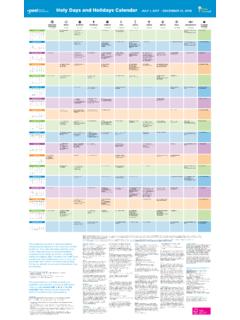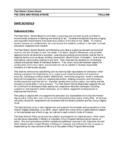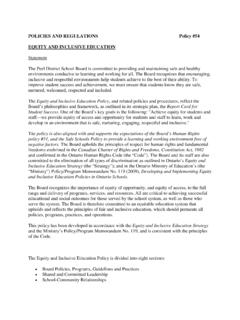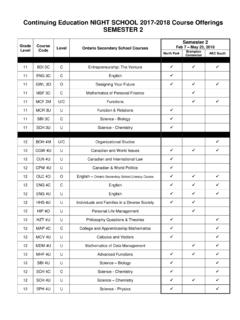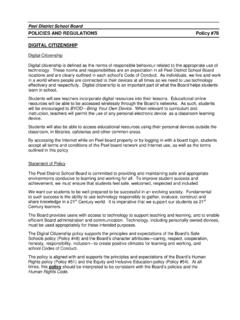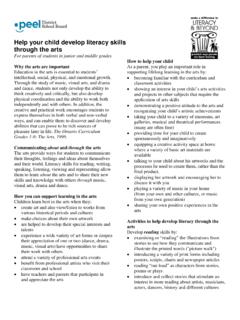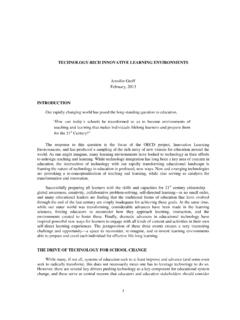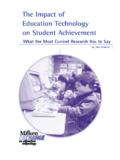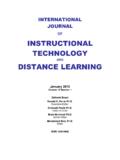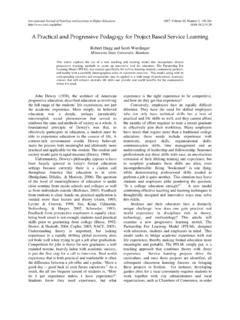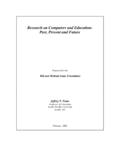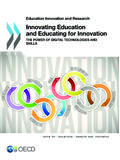Transcription of LEARNERS - Peel District School Board
1 #peel21stEMPOWERINGMODERN LEARNERSINSPIRE INNOVATE a focus on both thetech and the teach, weare committed toinspiring student successthrough theimplementation ofinnovative instructionalpractices, reliabletechnology and strongtechnical support, andequity of access for , we continue tocreate learningenvironments wheremodern LEARNERS areinspired to learn,collaborate, create andconnect with the PontesDirector of EducationPeel District School Board2WE BELIEVEEach LEARNER isCURIOUS,COMPETENT able to take anACTIVE ROLEin their own excellence by beingFLEXIBLEOPEN,and responsiveto their A POSITIVE, INNOVATIVE empowersGROWall of us toboth locally & , AUTHENTICT ogether as a COMMUNITY offamilies, educators and leaderswe share responsibility to INSPIREour modern LEARNERS to beACTIVE, CRITICALLYENGAGED, GLOBAL LEARNERS TO ACHIEVE3We live in a world of.
2 Technological innovations have createda world that is ever-connected and rapidly evolving, bringing new opportunities foremployment, civic engagement and learning , locally and globally. We remain committed toinspiring students to be today and in the CHANGEThis changing world demandsDriving this change is a transition toward a knowledge-based economy as well as complexchallenges that require innovative solutions. LEARNERS will need foundational skills, such asliteracy and numeracy, as well as a set of 21st century competencies skills, knowledgeand attitudes that will enable them to be engaged, successful citizens now and in thefuture.
3 Modern digital tools offer unprecedented opportunities toby providing access to information and learning networks. This access generates newopportunities for LEARNERS to explore their passions, share their voices and consider diverseperspectives that lead to an equitable and compassionate ever-changing world requires us, as educators, to be willing to in response to the needs of modern LEARNERS in a dynamic global context. By the skills, knowledge and attitudes that we hope to instill in our LEARNERS , weembody the competencies necessary for success in a modern world. Being a 21st centuryeducator is more about the journey than the journey requires.
4 All members of the community educators, parents/guardians, leaders and LEARNERS themselves are responsible todevelop active and critically engaged citizens today and in the hope this document sparkspersonal reflection, ongoingconversations, and shifts in practicethat inspire us to meet the needs andhonour the experiences of modernlearners in a changing world as weOUR MORAL IMPERATIVEC ompetencies for theModern LearnerCOLLABORATIONCOMMUNICATIONCRITICA L THINKING &PROBLEM-SOLVINGLEARNING TO LEARNGLOBAL CITIZENSHIPCREATIVITY,INNOVATION &ENTREPRENEURSHIPWe are educating ageneration of childrenand youth who haveno memory of a worldwithout the Internet,without instant accessto information, withoutan array of media attheir ideas presented in this document are not new.
5 They are, however, more essential nowthan ever. , our work is guided by the four belief statements on theprevious page. Also, the six innovative elements that follow are the actionable componentswe can unpack, discuss and implement as a learning Public SchoolBoards' Association21st Century Competencies: Foundation Paper for Discussion inspire success, confidence and hopein every , confident and hopefulRESILIENCY, critical thought and ALL learnersa collective commitmentmodellingINNOVATE ourpracticeMOVING FORWARD45 Future TenseAND PROBLEMS THAT WEDON'T YET KNOW WILL JOBS THAT HAVENOT YET BEEN CREATED,The objective of 21st centurylearning is to build capacity in areasthat promote a resilient societycapable of effectively adapting torapid prepare students TECHNOLOGIES THAT HAVENOT YET BEEN INVENTED6 INNOVATIVE ELEMENTSL earning CultureInformative AssessmentAccess to Technology21st Century CompetenciesLearning EnvironmentsModels of LearningValues and priorities that support a growth mindset andallow us to build knowledge together as a communityOngoing strategies and practices that continuouslyinform learning and teachingReliable and equitable access to information, resourcesand other digital technologiesKnowledge.
6 Skills and attitudes needed to learn and besuccessful in a modern worldDynamic physical, virtual and inclusive spaces designedto support learning and well-beingInstructional approaches that empower modern learnersTogether, these six innovative elements will help drive our work moving ELEMENTSin detailLEARNINGCULTUREINFORMATIVEASSESSME NTACCESS TOTECHNOLOGY21st CENTURYCOMPETENCIESLEARNINGENVIRONMENTSM ODELS learning process is one which engenders and reinforces wanting to learn [students] wanting to learn, the learning context is B. SarasonLearning cultures should foster curiosity, establish empathy amongst LEARNERS , andencourage lifelong learning . They promote a growth mindset, create safe spaces,and facilitate co- learning .
7 These dynamic cultures encourage and facilitateopportunities for purposeful risk-taking and agency in the learning process, whilefostering a questioning disposition. The creation of a sustainable learning culturerequires a unified commitment from classrooms, schools and the system as this shift in instructional design requires a corresponding shift in assessmentpractices. For students, assessment becomes less focused on documenting what hasand has not been learned and more focused on charting the learning journey forcontinued assessment guides every part of the learning process. Deep, lastinglearning is achieved when a transparent and equitable approach to assessment isused.
8 Active involvement of LEARNERS in the assessment process connects them withtheir learning and fosters reflection and a drive to learn more. Providing multipleand varied ways for LEARNERS to demonstrate learning and make their thinkingvisible allows for continuous, ongoing are successful learning cultures created and sustained?How is assessment used to inform the learning processfor educators, parents and students?At minimum, our certainty that the only thing we can claim about thefuture is its uncertainty provides reason enough to prepare students to bediversely skilled, nimble-minded and technologically savvy these competencies have always been essential, how have theyevolved over time, and why are they so important today?
9 An ever-changing world requires both foundational skills as well as 21st centurycompetencies for LEARNERS to be successful. These competencies include buildingknowledge, developing skills and cultivating attitudes which are excel when they feel safe, challenged, and in control of their ownlearning. learning environments involve far more than the physical and virtualclassroom; they support a climate that nurtures well-being and responds to thecognitive, emotional, and social needs of LEARNERS . These spaces should beintentionally designed and co-constructed by everyone involved in the learningprocess. A dynamic learning environment is responsive, flexible and adaptable.
10 It is about creating stimulating School environments and these may notalways be contained within four do we co-create a learning environment that supports all LEARNERS ?To truly be empowered, people need both ownership and autonomy. In a world of immediate access to information, we must integrate models oflearning that are student-centred and facilitate relevant and authenticexplorations of that information. Knowledge building, inquiry, design thinking,and blended learning are a few possible frameworks that allow LEARNERS toexplore big ideas, make real-world connections and link to their passions, whileintegrating technology . Employing a variety of learner-inspired models makeslearning meaningful and the curriculum authentic.

